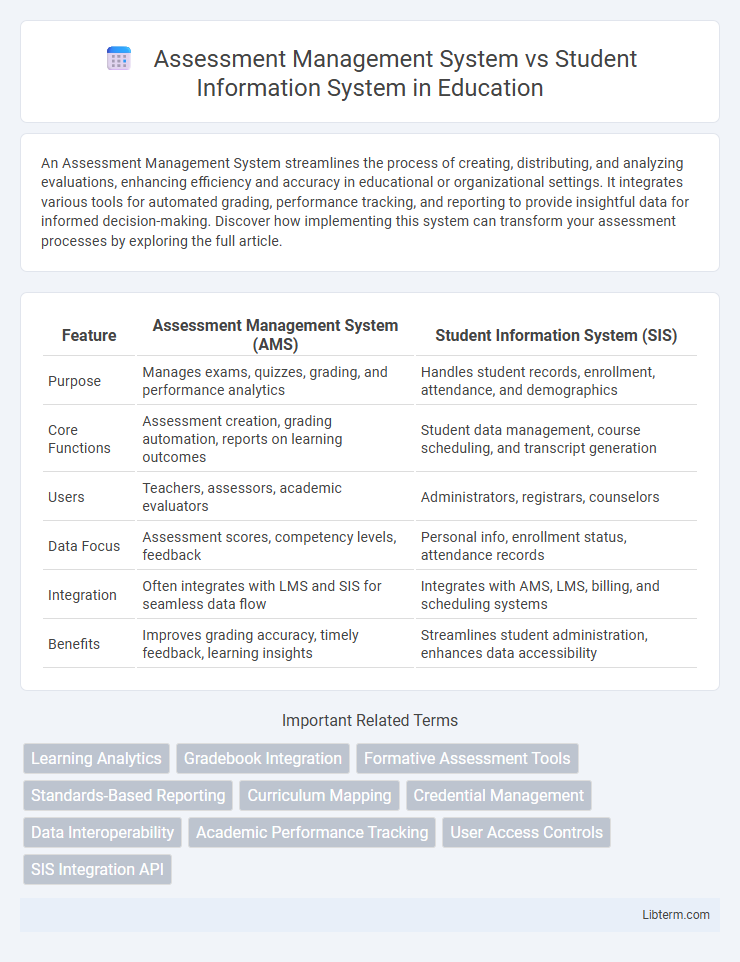An Assessment Management System streamlines the process of creating, distributing, and analyzing evaluations, enhancing efficiency and accuracy in educational or organizational settings. It integrates various tools for automated grading, performance tracking, and reporting to provide insightful data for informed decision-making. Discover how implementing this system can transform your assessment processes by exploring the full article.
Table of Comparison
| Feature | Assessment Management System (AMS) | Student Information System (SIS) |
|---|---|---|
| Purpose | Manages exams, quizzes, grading, and performance analytics | Handles student records, enrollment, attendance, and demographics |
| Core Functions | Assessment creation, grading automation, reports on learning outcomes | Student data management, course scheduling, and transcript generation |
| Users | Teachers, assessors, academic evaluators | Administrators, registrars, counselors |
| Data Focus | Assessment scores, competency levels, feedback | Personal info, enrollment status, attendance records |
| Integration | Often integrates with LMS and SIS for seamless data flow | Integrates with AMS, LMS, billing, and scheduling systems |
| Benefits | Improves grading accuracy, timely feedback, learning insights | Streamlines student administration, enhances data accessibility |
Introduction to Assessment Management Systems (AMS)
Assessment Management Systems (AMS) streamline the creation, administration, and grading of various student assessments, enabling educators to efficiently track academic performance and competency levels. These systems integrate secure test delivery, automated scoring, and detailed analytics to enhance data-driven decision-making. Unlike broader Student Information Systems (SIS) that manage overall student records and administrative functions, AMS specifically focuses on optimizing assessment workflows and outcomes within educational institutions.
Overview of Student Information Systems (SIS)
Student Information Systems (SIS) centralize student data management, including enrollment, attendance, grades, and personal information, providing a comprehensive digital platform for educational institutions. These systems streamline administrative tasks, facilitate communication between faculty, students, and parents, and support reporting and compliance with educational standards. SIS integrates with other tools like Assessment Management Systems to enhance academic tracking and improve decision-making processes in schools and universities.
Core Features of Assessment Management Systems
Assessment Management Systems (AMS) specialize in creating, delivering, and grading exams and assignments, offering features like automated scoring, item analysis, and real-time performance tracking. Unlike Student Information Systems (SIS), which manage broader student data such as enrollment, attendance, and transcripts, AMS focuses on assessment lifecycle management, including question bank organization, customizable rubrics, and secure test administration. Integration with learning management systems and analytics tools enhances data-driven insights into student learning outcomes within AMS platforms.
Key Functions of Student Information Systems
Student Information Systems (SIS) streamline administration by managing student enrollment, attendance tracking, grade reporting, and transcript generation, ensuring efficient data accessibility and accuracy. These systems also support scheduling, communication between students, parents, and staff, and integration with learning management systems to provide a comprehensive educational experience. In contrast, Assessment Management Systems primarily focus on creating, administering, and analyzing exams and assessments without encompassing the broad administrative functions of SIS.
Differences in Data Management: AMS vs SIS
Assessment Management Systems (AMS) focus primarily on collecting, storing, and analyzing student assessment data such as test scores, grading rubrics, and performance metrics, enabling detailed evaluation of learning outcomes. In contrast, Student Information Systems (SIS) manage comprehensive student data including enrollment, attendance, demographics, and academic records, serving as a centralized repository for overall student administration. AMS offers specialized tools for assessment data integration and reporting, whereas SIS provides broader functionalities for managing diverse student information and supporting institutional operations.
Impact on Teaching and Learning
Assessment Management Systems streamline the creation, administration, and analysis of student assessments, enabling educators to identify learning gaps and tailor instruction for improved student outcomes. Student Information Systems provide comprehensive data on student demographics, attendance, and academic records, supporting personalized learning plans and administrative efficiency. Together, these systems enhance teaching effectiveness and promote data-driven decision-making in educational environments.
Integration Capabilities Between AMS and SIS
Assessment Management Systems (AMS) and Student Information Systems (SIS) demonstrate critical integration capabilities that streamline academic data flow, enabling real-time synchronization of student performance metrics and attendance records. Seamless API connections facilitate bi-directional data exchange, ensuring consistency across gradebooks, assessment results, and enrollment information, which reduces data redundancy and manual entry errors. Enhanced interoperability between AMS and SIS supports comprehensive reporting and analytics, empowering educators with actionable insights to tailor instruction and improve student outcomes.
Security and Privacy Considerations
Assessment Management Systems prioritize secure handling of exam data through encryption and role-based access controls, minimizing the risk of unauthorized access. Student Information Systems implement comprehensive privacy measures by complying with regulations like FERPA and GDPR, ensuring protection of sensitive student records. Both systems require robust authentication mechanisms and regular security audits to safeguard data integrity and confidentiality.
Choosing the Right System for Your Institution
Selecting the appropriate system hinges on your institution's primary needs: an Assessment Management System excels in streamlining test creation, grading, and analytics, while a Student Information System offers comprehensive management of student data, enrollment, and academic records. Evaluating factors such as integration capabilities, user interface, scalability, and reporting features ensures alignment with institutional goals and operational efficiency. Prioritizing customization and real-time accessibility will optimize administrative workflows and enhance both faculty and student experiences.
Future Trends in Educational Technology Systems
Assessment Management Systems are increasingly integrating AI-driven analytics to provide real-time, personalized feedback, enhancing adaptive learning environments. Student Information Systems are evolving with blockchain technology to ensure secure, transparent student records and facilitate seamless data sharing across institutions. Future trends emphasize interoperability, cloud-based solutions, and data privacy, shaping the next generation of educational technology ecosystems.
Assessment Management System Infographic

 libterm.com
libterm.com